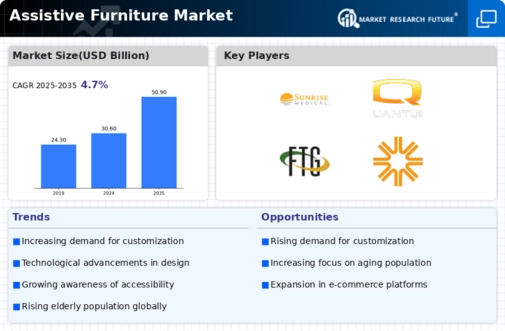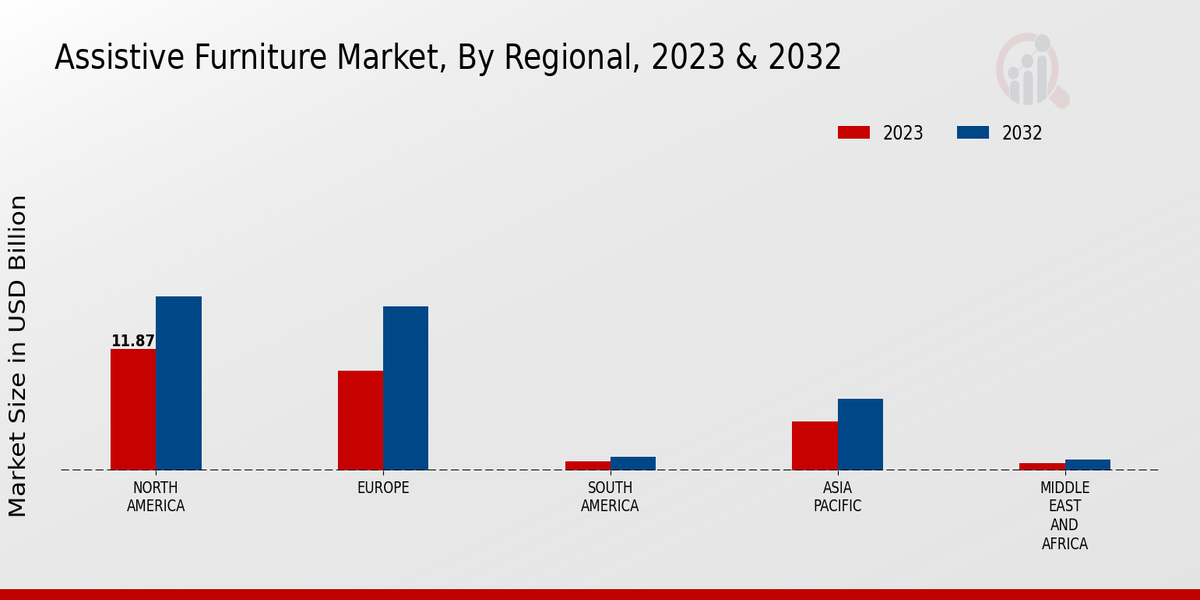Aging Population
The aging population is a primary driver of the Global Assistive Furniture Market Industry. As individuals age, they often experience mobility challenges, necessitating the use of assistive furniture to enhance their quality of life. By 2024, the market is projected to reach 30.6 USD Billion, largely due to the increasing demand for products designed for elderly individuals. This demographic shift indicates a growing need for specialized furniture that accommodates their unique requirements, such as adjustable beds and ergonomic chairs. The trend suggests that as the population continues to age, the market will likely expand, reflecting the importance of accessibility in living environments.
Rising Disability Rates
Rising disability rates globally contribute significantly to the Global Assistive Furniture Market Industry. With an increasing number of individuals living with disabilities, there is a heightened demand for furniture that supports their specific needs. This includes items like wheelchair-accessible tables and recliners designed for ease of use. The World Health Organization reports that approximately 15 percent of the global population lives with some form of disability, which underscores the necessity for assistive furniture. As awareness and advocacy for disability rights grow, the market is expected to expand, potentially reaching 50.9 USD Billion by 2035, reflecting the ongoing commitment to inclusivity.
Market Growth Projections
The Global Assistive Furniture Market Industry is poised for substantial growth, with projections indicating a market size of 30.6 USD Billion in 2024 and an anticipated increase to 50.9 USD Billion by 2035. This growth trajectory suggests a compound annual growth rate of 4.73 percent from 2025 to 2035. Such projections highlight the increasing demand for assistive furniture, driven by factors such as an aging population, rising disability rates, and technological advancements. The market's expansion reflects a broader societal shift towards inclusivity and accessibility, indicating a promising future for the industry.
Technological Advancements
Technological advancements play a crucial role in shaping the Global Assistive Furniture Market Industry. Innovations in materials and design have led to the development of more functional and aesthetically pleasing assistive furniture. For instance, smart furniture equipped with sensors and connectivity features enhances user experience and safety. The integration of technology not only improves usability but also appeals to a broader audience, including younger individuals with disabilities. As these advancements continue, the market is likely to see a compound annual growth rate of 4.73 percent from 2025 to 2035, indicating a robust future driven by innovation.
Increased Awareness and Advocacy
Increased awareness and advocacy for disability rights and accessibility are pivotal drivers of the Global Assistive Furniture Market Industry. As society becomes more conscious of the challenges faced by individuals with disabilities, there is a growing demand for assistive furniture that promotes independence and comfort. Advocacy groups are actively working to raise awareness about the importance of accessible living spaces, which in turn influences consumer behavior. This heightened awareness is likely to contribute to the market's growth, as more individuals seek out products that cater to their needs, thereby fostering a more inclusive environment.
Government Initiatives and Funding
Government initiatives and funding significantly influence the Global Assistive Furniture Market Industry. Many countries are implementing policies aimed at improving accessibility for individuals with disabilities and the elderly. These initiatives often include financial support for assistive devices and furniture, making them more accessible to those in need. For example, various government programs provide grants or subsidies for purchasing assistive furniture, which can stimulate market growth. As governments recognize the importance of inclusivity, the market is expected to benefit from increased funding and support, further driving its expansion in the coming years.















